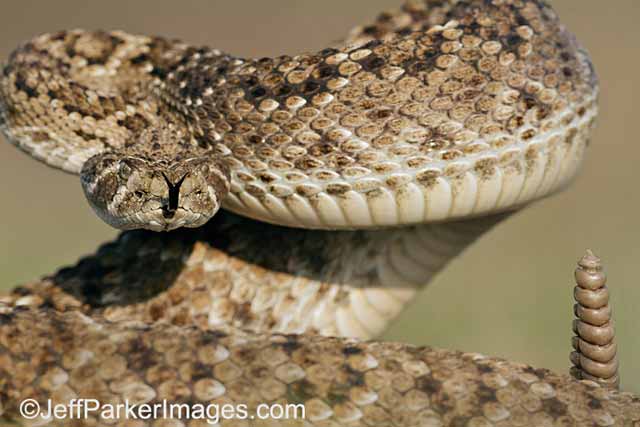
One of the biggest challenges in snake photography when out in the wild is creating an interesting image. A photo of a snake lying on the ground just won’t hold the viewer’s attention.
Action, posture, detail, and background can all add interest to your snake photos.
But, before you set out to photograph snakes in the wild, note these two important safety tips:
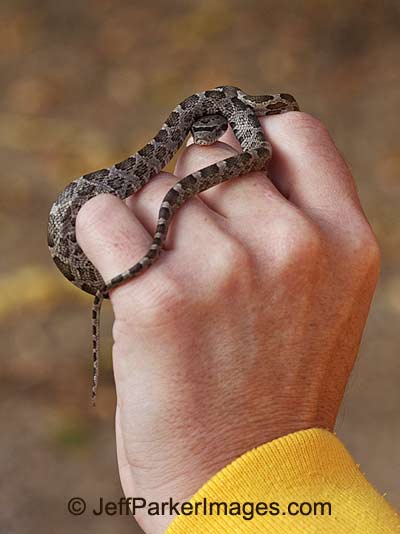
Know your snakes well! I CANNOT stress this enough!
Learn more than just which ones have venom! Even non-venomous snakes bite, while others are endangered or threatened species. Also, familiarizing yourself with their “personality” traits helps anticipate behavior worth photographing.
Wear proper attire.
Don boots and snake-guards when “bushwhacking” for scaly subjects. Wear gloves when handling snakes (even bites that don’t transmit venom can create infection).
IF YOU CATCH A SNAKE: Always treat the snakes you photograph with respect.
Let the snake go where you found it.
After photographing a snake in the wild, release it exactly where you captured it unless doing so endangers it.
Don’t keep the snake too long.
A captured snake doesn’t know you don’t intend it harm. It undergoes physiological stress, which uses some of its vital resources. Retaining a wild snake too long compromises its ability to survive upon release.
Don’t cause the snake any additional stress.
As noted, the snake’s already experiencing stress, so handle it as little as possible. Minimize loud noises and jerky movements.
VARIETIES OF SNAKES AND MORE SNAKE PHOTOGRAPHY PHOTO TIPS
Jumping Viper
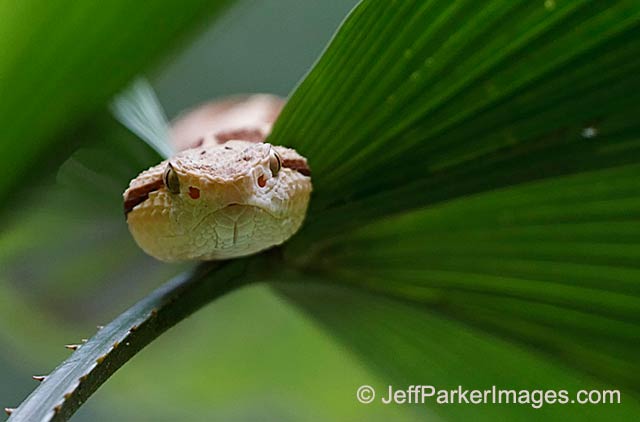
Adult Jumping Vipers average a half-meter long (about 2-feet), but this young snake, which I photographed during a tour I led in Honduras, measured only about half that.
Snakes can strike at a distance of about one-half their body length. With this snake measuring 12” (approx. 30-centimeters), that meant I could work really close to it. But, considering its bite imparts a hemotoxic venom that breaks down red blood cells to make prey easier to digest, calm snake or no, I wasn’t keen on working in macro.
Instead, I shot from 6-feet (almost 2-meters) away with a 100-400mm lens. I achieved this image with the lens at 370mm.
These slow-moving snakes possess a calm temperament, which is why our handler chose this species as our “model.” In the low light of the rainforest, its mellowness came in handy by allowing us to use slower shutter speeds.
With snake photography, background is important. To make it interesting, I used the lines and shadows of the palm frond to lead the eye to the snake.
Texas Indigo Snake
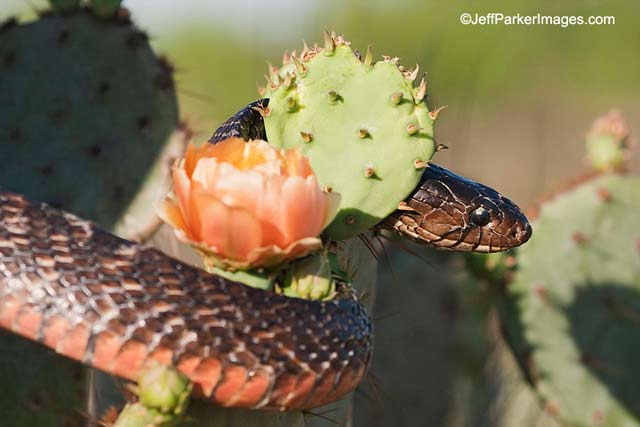
Indigo Snakes are the longest native snakes in North America and the longest on record measured 2.74 meters (9 ½ feet). But, while the size impresses, a photo of a long, black snake stretched out impresses no one so that left me looking for a way to add pizzazz. Think out of the box in such situations.
For example: Does an Indigo climb cactus? No, but does the viewer ask him/herself that question? No. Now, if you photographed the snake out of its habitat—say on a rosebush—you’d have a problem.
Texas classifies its Indigos as a state threatened species, so we worked with this one only a short while and released it exactly where we’d found it. The lighting appears less than perfect because I’d found—and therefore photographed—the snake at mid-day.
Sure, I could have held onto it until dusk’s sweet light, but that would’ve meant more time in captivity and more stress for this threatened species.
Western Diamondback Rattlesnake
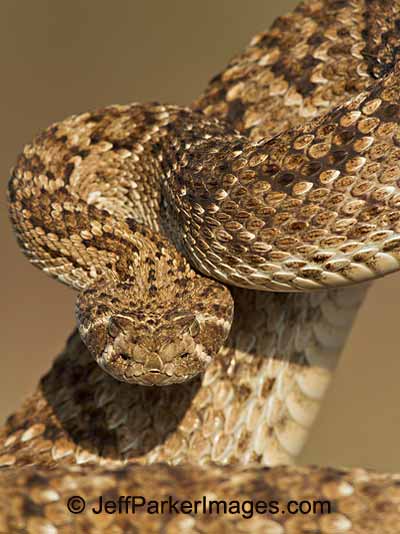
I spotted this Western Diamondback crossing a South Texas sendero. When he saw me he turned to leave because, contrary to lore, these venomous pit vipers would much rather leave the scene than make one. He’s coiled here because, upon my frantic return from the truck with my camera, I startled him into this defensive position.
Please note—IMPORTANT! While practising snake photography I kept at least 20-feet away and used a 600mm lens. With such a big lens, the snake entirely fills the frame, giving me no need to draw nearer.
Notice how difficult it is to see its eyes? Like all snakes, the Western Diamondback doesn’t have eyelids. Instead, it has eye caps with colors and patterns similar to its skin, which assist with camouflage. I bring this up because when photographing snakes in the wild focusing on the eye is imperative; however, when they have camouflaged eye caps doing so can really challenge you.
Western Coachwhip
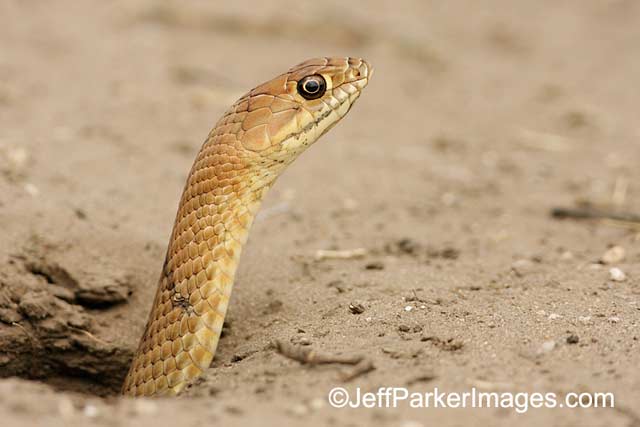
Western Coachwhips are the Speedy Gonzales’ of the snake world, so when this one unexpectedly poked up its head while I photographed something else, I decided he was my new subject. Because they’re so quick, I knew his re-emergence would provide my only chance for a good photo. After six hours of waiting, he materialized again and I got the opportunity create some images.
Because I know this species well, I didn’t lie on my stomach for an eye-level shot like I often do. These feisty snakes have been known to suddenly turn around and pursue photographers, so I didn’t fancy being on the ground when this one surfaced!
A 600mm lens enabled me to wait far enough from the hole so as not to startle the Coachwhip. In situations like this—where there’s not much color—capturing the catch-light in an animal’s eye can save an image.
Rat Snake
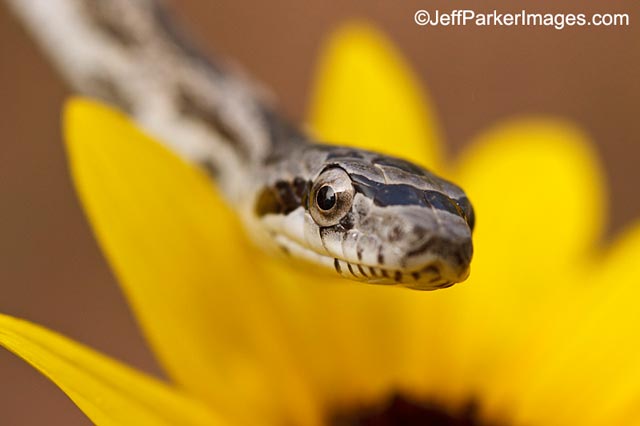
This non-venomous juvenile Rat Snake possessed such an aggressive temperament that I couldn’t have photographed him without a handler. Thankfully, its size didn’t match its attitude.
The Macro Lens in Snake photography
I used a macro lens so I could capture the myriad details of its eye. In this image I couldn’t have both its nose and eye in focus since they’re on two different focal planes. In such a situation the choice is always easy: choose the eye!
When working in macro, remember that background! It’s just as important as always. When searching for a suitable background for a subject like this you want something that feels “believable,” is solid enough not to distract, and a color that compliments the animal (brown is made partly from yellow, so that worked nicely here).
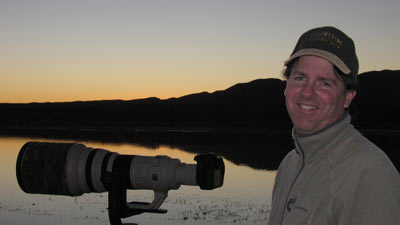
Award-winning, naturalist photographer, Jeff Parker, leads the naturally curious on photo tours throughout North and Central America.
Be sure to visit his website and learn more about how you can Explore in Focus™ with him
by Jeff Parker


Leave a Reply